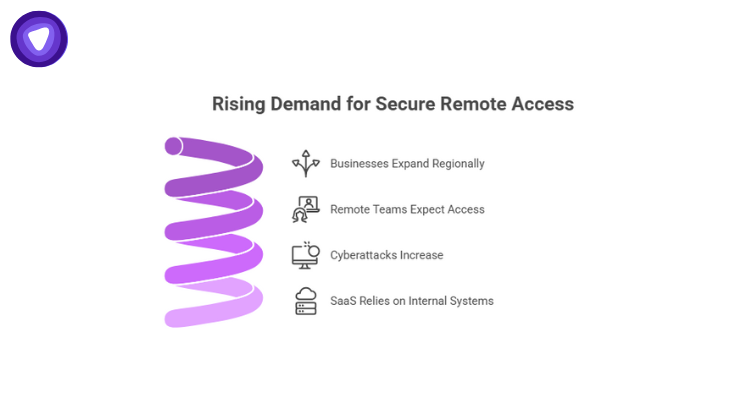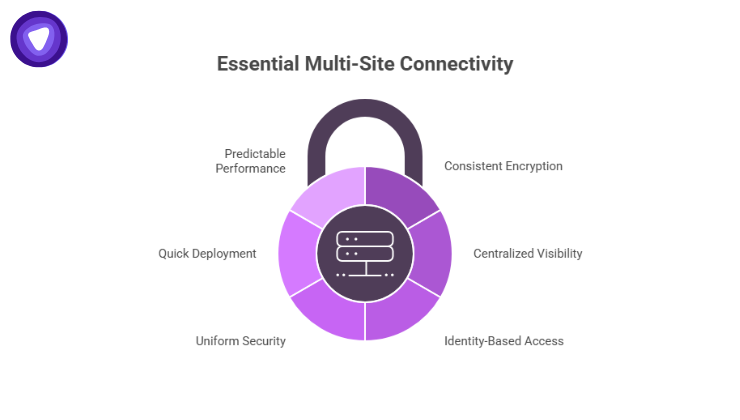- Multi-Site Connectivity: Essential for MSPs to provide consistent, secure access across client offices and remote teams.
- Software-Defined Approach: Reduces deployment time, simplifies management, and improves scalability compared to legacy hardware solutions.
- Security & Management: Centralized dashboards, identity-based access, and encrypted tunnels strengthen security and streamline operations.
- Standardization & Remote Support: Standardized site architecture and integrated remote worker support ensure predictable performance and minimal disruptions.
- Business Impact: Reliable multi-site connectivity enhances client productivity, lowers operational overhead, and builds trust, contributing to long-term success.
Clients expect their offices, teams, and remote staff to function as one unified environment. They want files to load instantly, internal dashboards to run without delays, and employees to move between locations without losing access to systems.
This expectation creates pressure on MSPs to deliver consistent, high-integrity connectivity across every site they manage. Multi-Site Connectivity for MSPs has therefore become a core service, not an optional add-on.
Yet stitching together distributed offices with secure remote access is rarely simple. Every client location carries its own hardware, ISP quality, traffic loads, and user behaviors. Remote workers further complicate the environment with diverse devices and inconsistent home networks.
For MSPs, the challenge is to build a secure, predictable, scalable network fabric that ties all of these elements together without creating overhead.
Why Multi-Site Connectivity For MSPs Is Now Fundamental

The last few years reshaped the way organizations operate. Multi-site offices grew, satellite teams increased, and hybrid work became part of standard business operations. MSPs now manage infrastructures that resemble miniature distributed enterprises.
Several shifts explain this rising demand:
- More businesses run regionally distributed branches.
- Remote teams expect access to internal resources from anywhere.
- Cyberattacks on small and mid-sized organizations increased by 22 percent between 2023 and 2024, according to industry reporting.
- SaaS workflows still depend on private internal systems at many companies.
MSPs handle these expectations by delivering consistent connectivity across sites without sacrificing visibility or control.
The Core Challenges MSPs Face When Linking Multiple Client Sites

Multi-Site Connectivity for MSPs sounds straightforward. In practice, it introduces several operational challenges.
1. Inconsistent network environments
Client sites rarely mirror one another. Hardware generations differ. Local ISP quality varies. Some offices store critical applications locally, while others rely heavily on cloud platforms. Creating a standard across them is difficult.
2. Security gaps between locations
Branch offices often lack the same protections as the primary site. Remote workers introduce additional risk, especially when using home routers that are rarely updated. Cybercriminals target these weak links to gain access to internal systems.
3. High maintenance load
Traditional site-to-site networking requires device configuration, firmware checks, credential management, and tunnel monitoring. For MSPs managing dozens of clients, this becomes labor-intensive.
4. Poor user experience
If latency, packet loss, or bandwidth limitations arise, employees complain. MSPs then face pressure to troubleshoot issues that originate far outside their control.
5. Limited scalability
Clients expand quickly. A new department, remote contractor, or branch location may need immediate connectivity. MSPs need solutions that grow without re-architecting the network.
What Modern Multi-Site Connectivity Should Deliver

To support current and future client demands, MSPs need reliable, predictable, and secure multi-site connectivity. At minimum, the infrastructure should provide:
Consistent encrypted tunnels
A reliable method to move traffic between offices, servers, and remote users using modern encryption standards.
Centralized visibility
A single point of control for policy, monitoring, user access, and location performance across all clients.
Identity-based access
Granting access to systems based on user roles rather than traditional IP restrictions.
Uniform security policies
Every site and remote user follows the same access rules, authentication requirements, and traffic handling.
Quick deployment
MSPs should be able to bring new client sites online within minutes rather than days.
Predictable performance
Networks should deliver stable speeds and low-latency routing, avoiding erratic behavior across regions.
The Evolution of Multi-Site Architectures For MSPs

Multi-Site Connectivity for MSPs traditionally relied on hardware appliances and MPLS circuits. Although reliable, these systems are expensive, slow to deploy, and designed for large enterprises.
The shift toward cloud-first infrastructure opened more practical models:
- Software-based site connectors: Lightweight modules or virtual appliances installed in branch offices or local servers create secure tunnels without heavy hardware requirements.
- Zero trust access for remote workers: Instead of wide-open networks, users receive access only to the resources they need.
- Global private routing fabric: Traffic can pass through managed private servers for lower latency and controlled routing.
- Unified client portals: MSPs manage all client networks from one dashboard rather than juggling multiple tools.
This approach removes many historical bottlenecks, reduces dependency on legacy hardware, and enables MSPs to offer multi-site connectivity to smaller organizations that previously could not afford it.
Why MSPs Need a Secure, Software-Defined Approach

A software-driven network model helps MSPs support clients more efficiently while meeting modern security expectations.
Stronger security controls
Remote workforce security became critical as distributed staff grew. Reports from 2024 show that 67 percent of breaches at small businesses originated from remote access weaknesses. Encrypted tunnels and identity-based policies close these gaps.
Faster rollouts
Software-based connectors can be deployed at branch offices in under an hour. This helps MSPs respond quickly to client requests.
Lower operational effort
Centralized dashboards cut down on manual reconfiguration and recurring maintenance.
Optimized routing
With private infrastructure acting as transport, MSPs avoid the instability of consumer-grade home networks and low-cost ISP routes.
Comparison of Traditional vs Modern Multi-Site Connectivity Approaches
The table below highlights the key differences between legacy networking methods and modern software-defined connectivity for MSPs.
| Criteria | Traditional MPLS / Hardware VPN | Modern Software-Defined Connectivity |
| Deployment time | Weeks to months | Minutes to hours |
| Cost | High recurring circuit fees | Predictable subscription model |
| Scalability | Limited, slow expansion | Rapid addition of sites and users |
| Security | Static rules, hardware-dependent | Identity-based access, updated encryption |
| Visibility | Fragmented across devices | Central management portal |
| Remote worker support | Add-on, rarely seamless | Integrated with core design |
How MSPs Can Build a High-Integrity Multi-Site Framework for Clients

A secure and reliable multi-site network for client offices and remote workers requires thoughtful planning. MSPs can follow these steps to build environments that remain stable long-term.
Step 1: Standardize site architecture
Create a template for client offices that defines:
- Site connector type
- Enforcement rules
- Access policies
- Traffic routing expectations
This avoids custom configurations for every location.
Step 2: Implement a unified identity and access control model
Users should authenticate with strong verification before being allowed to access systems. This reduces reliance on IP allowlists and outdated password methods.
Step 3: Establish dedicated encrypted paths
Create consistent tunnels between locations and critical systems. This protects traffic and ensures predictable performance.
Step 4: Prioritize remote worker integration
Remote teams need the same access reliability as office locations. Software agents on their devices should connect to the same unified architecture.
Step 5: Monitor performance and user behavior
Centralized dashboards allow MSPs to detect abnormal traffic, identify risky access attempts, and make adjustments quickly.
Step 6: Maintain consistent update cycles
Security patches and connector updates must be applied across all sites without manual intervention.
The Business Impact: Why This Matters for MSPs and Their Clients

When MSPs deliver reliable multi-site connectivity:
- Client productivity improves
- Internal systems remain accessible from any location
- Security risks decline
- Operational overhead drops
- Client trust increases
This directly contributes to longer service contracts and smoother day-to-day operations.
A 2025 infrastructure survey indicated that organizations supporting distributed sites with consistent secure access experienced 51 percent fewer disruptions compared to those relying on traditional networking methods. This demonstrates the real impact of modern, software-defined connectivity on business continuity.
Where PureVPN White Label VPN Solution Fits in
MSPs that want a fully managed, software-based model for Multi-Site Connectivity often need a solution that supports both branch offices and remote workers without heavy infrastructure. PureVPN White Label VPN Solution helps achieve this through dedicated gateways, unified dashboards, encrypted tunnels, and identity-based access controls.
The solution gives MSPs the ability to deploy secure links between sites in minutes, manage all client networks from one place, and offer remote teams consistent access to internal systems. It reduces the complexity of multi-site management and provides a predictable framework for performance and security.
Closing Thoughts
Multi-Site Connectivity for MSPs is now a baseline requirement for delivering effective IT services. As organizations rely on multiple offices, distributed teams, and hybrid environments, MSPs must provide a secure, unified network fabric that keeps workloads stable and data protected.
A software-driven approach creates a foundation that scales with clients and removes the friction associated with traditional site-to-site infrastructure.


